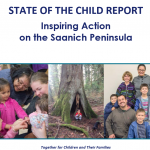One of our chief responsibilities as a CCRR program is to assist parents who “are looking for child care”. With further exploration, our Referral Consultants find that many parents are looking for a quality child care program that incorporates a preschool component. Shauna and Lisa take time to explain to these parents that the quality indicators are the same for both child care and preschool. The only difference is how long a day the child will be in the program.
Parents and educators sometimes hold the belief that child care centers and preschool programs perform very different functions. Child care is viewed as custodial care. Preschool programs are often seen as offering school readiness for kindergarten. Whichever program a child attends, it will need to address the varied needs of each individual child. Our CCRR program does not distinguish between these two types of settings when we provide parents with documents that speak to quality programs for children. The indicators for quality care are the same.
All child care settings should have a written (and observed!) philosophy about how children learn and should be raised. A high quality program, regardless of the number of hours a child is in attendance, should foster all domains of a child’s development (the social, emotional, cognitive, physical, and spiritual needs). An educated and dedicated educator should ensure that each child is awarded opportunities to foster each area of development. Time should be taken for each child in the program to have a connection with at least one educator each time the child is at the facility.
A quality program should have a plan of activities for the day, but should also allow for independence and fresh ideas to be generated by the children. Our culture appreciates children being encouraged to be independent and self-confident. The plan of activities should allow for children to work independently and in groups, negotiating, problem-solving, and critically thinking for themselves. The educator should be a resource to the setting, providing tools, materials, prompts, and encouragement for the work that is developing from the child. The educator should model appropriate behaviours that the children can mirror in their day-to-day interactions with others.
The morning plan of activities for child care and preschool should be very similar. One marked difference is that typically preschool children arrive for a set time in the morning, optimizing the limited hours that the child has in the setting. Child care typically allows a more flexible drop off time based on the working hours of the parents. Child care will have lunch and nap time added to the planned activities, followed by a similar routine for the afternoon as was observed in the morning. One large benefit to a child attending a full day program in child care is that a project or concept that was being explored in the morning can continue later in the day. The intensity of the learning can be played out further and more time awarded to gather materials to extend the “play”. In our rushed society this can be a real benefit to a child.
Educators in all types of settings must be active participants with the children’s learning. Preschool settings should attend to the social and emotional needs just as much as the more measurable academic outcomes of the children. I believe that a child needs to be “settled” emotionally and socially in a setting before the other learning areas can be tackled successfully. Our society has placed a lot of emphasis on school readiness and intellectual outcomes. I believe that this has made the early years a time of worry and concern for parents. Parents want what is best for their children and they want their children to receive the best care and early childhood learning opportunities. Quality child care is a program that incorporates the best of a preschool program, but in a full day routine.
Belinda Macey, Program Coordinator



